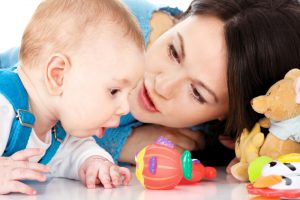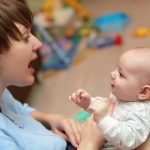 You’ll have your first conversation with your baby long before her first word. Babbling starts around 5 months, and research shows that responding to your baby’s babbling in a meaningful way can boost her language development.
You’ll have your first conversation with your baby long before her first word. Babbling starts around 5 months, and research shows that responding to your baby’s babbling in a meaningful way can boost her language development.
|
Highlights:
|
Language is So Much More Than Words
When we think of language development, babies saying first words comes to mind. Speech, though, is just one aspect of language, which encompasses three main areas:
Receptive Language: Understanding language that communicates thoughts, feelings, ideas or concepts.
Expressive Language: Using language to communicate thoughts, feelings, ideas or concepts.
Pragmatic Language: Using language to navigate social situations, including nonverbal cues.
When you respond to your baby’s babbling (whether with babbling or actual words) in a meaningful way, you expose her to all three areas of language. You can have full conversations—complete with varying tones of voice, facial expressions, and gestures—long before she says her first word!
What is a ‘Meaningful’ Response?
Researchers at The University of Iowa found that in order to reap the language-boosting benefits of responding to your baby’s babbles, your responses must be thoughtful: Listening, trying to figure out what she’s communicating, labeling, elaborating and using nonverbal cues like eye contact, facial expressions and gestures.
Here are some of the ways meaningful responses to your baby’s babbling can maximize her language learning:
Encourages Back-and-Forth Communication
Speech-language pathologist, Mandy Alvarez, highlights that responding to your baby’s babbling reinforces the reciprocal nature of communication.
“When your baby says ba and you say ba back, she thinks, I did that! I made her say ba!” says Alvarez. “She learns that she has the power to initiate communication and elicit a response.” This is motivating for her, and she’ll likely keep going as long as you keep responding. Keeping her talking is great for her speech development, because she gets a lot of practice experimenting with new speech sounds.
An additional benefit of back-and-forth communication is that it introduces your baby to pragmatic language skills like eye contact, turn-taking and listening.
Gives Meaning to Words
If your baby looks at her cup and babbles, a meaningful response might be: That’s your cup. Are you thirsty? Here you go! You can drink. Mmm.” Figuring out what she’s “talking” about and building on that teaches her that words have meaning and can be used together to express something.
Labeling and elaborating in this way helps build your baby’s vocabulary. Because receptive language develops before expressive language, she will understand many words before she is able to say one.
Builds Nonverbal Language Skills
Nonverbal language is an enormous part of human interaction. Tone of voice, facial expression, body position, and gestures all communicate much more than the words we say. For instance, the word hello means something completely different if you say it with a smile while leaning in than if you say it with a straight face and stiff body.
Engaging responses to babbling teach your baby that non-verbal cues have meaning (Mom’s making eye contact, that means she’s listening; Mom’s smiling, that means I should keep going). You will notice her mimic and eventually use nonverbal language herself.
Alvarez emphasizes that learning how to read and use nonverbal language is one of the key elements of social communication, or being able to relate to others and navigate the complex nuances of social interactions.
In addition to teaching your baby invaluable language skills, your responsiveness to her babbling also helps optimize her brain development. Repeating ba or going on and on about the cat she sees out the window are powerful tools in your parent toolbox!








